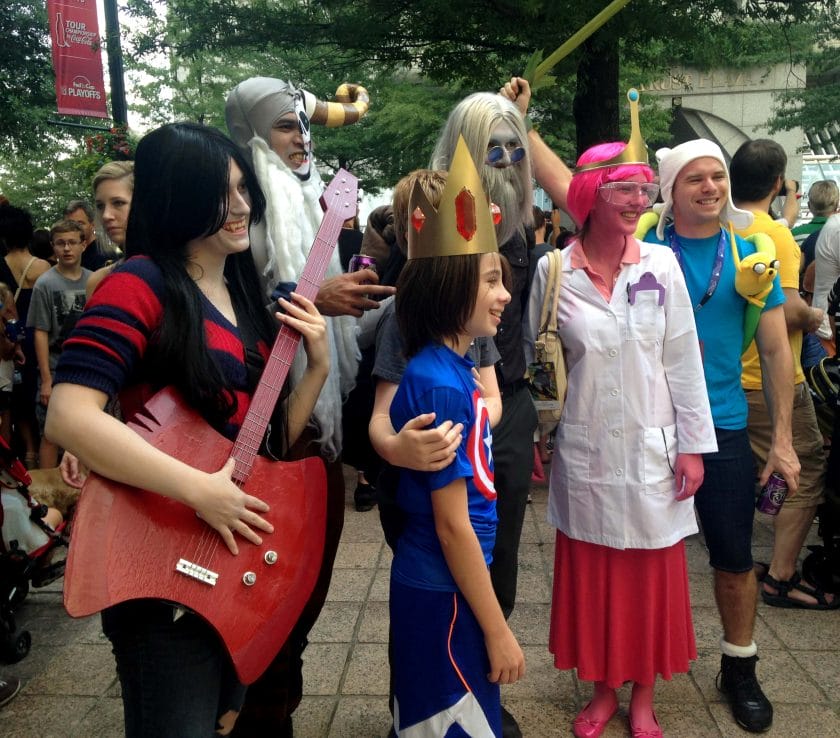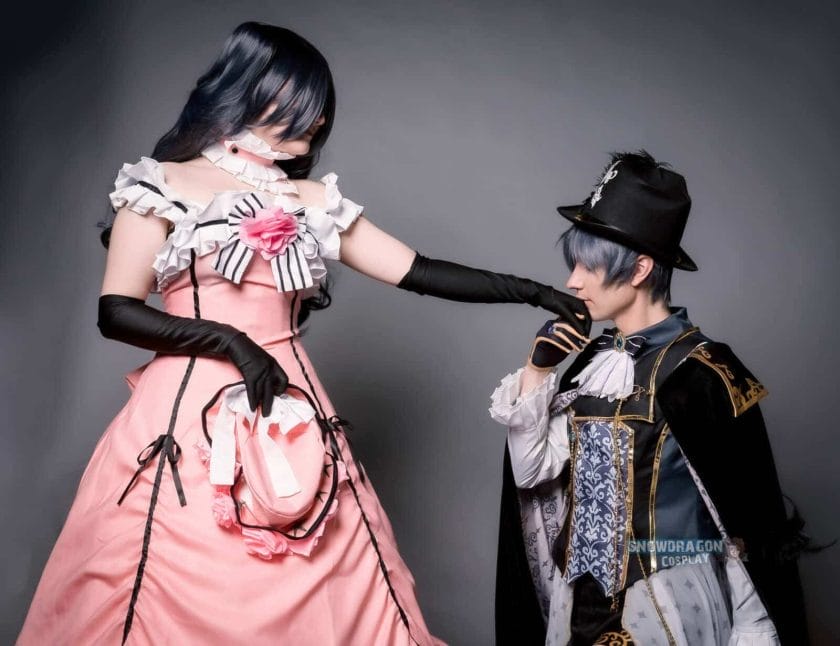[publishpress_authors_box layout="ppma_boxes_840322"]

1. The Emergence of Cosplay: A Look into its Origins
The Birth of Cosplay
Cosplay, short for “costume play,” is a phenomenon that has taken the world by storm. But have you ever wondered how it all began? The origins of cosplay can be traced back to the 1930s in America, where fans of science fiction and fantasy literature would dress up as their favorite characters for conventions and gatherings. These early pioneers laid the foundation for what would become a global cultural phenomenon.
One notable event that marked the emergence of cosplay was the World Science Fiction Convention held in New York City in 1939. Attendees were encouraged to come in costume, and this sparked a wave of creativity among fans who wanted to embody their beloved characters. From there, cosplay slowly gained traction within niche communities.
The Influence of Japanese Pop Culture
While cosplay had its beginnings in America, it was Japan that truly embraced and popularized the hobby. In the 1970s and 1980s, Japanese manga and anime started gaining international recognition, captivating audiences with their vibrant characters and intricate storylines. Fans became inspired to bring these characters to life through cosplay.
In Japan, events like Comiket (Comic Market) became hotspots for cosplayers to showcase their costumes and connect with fellow enthusiasts. These gatherings provided a platform for people to express their love for their favorite fictional worlds while also allowing them to showcase their creativity and craftsmanship.
A Global Phenomenon
In recent years, cosplay has transcended borders and become a global phenomenon. Social media platforms like Instagram and YouTube have played a significant role in spreading awareness about cosplay, allowing cosplayers from around the world to share their creations with a wider audience.
Today, cosplay is not limited to conventions and gatherings; it has become a part of everyday life for many enthusiasts. From attending movie premieres in costume to participating in charity events, cosplayers find joy in embodying their favorite characters and bringing a touch of fantasy into the real world.
2. Recognizing Cosplay as a Hobby: The Beginning of a Cultural Phenomenon
The Shift from Niche Interest to Mainstream Recognition
Once considered a niche interest, cosplay has now gained mainstream recognition as a legitimate hobby and form of artistic expression. This shift can be attributed to several factors that have contributed to the cultural phenomenon we see today.
Media Representation and Popularity
In the early 2000s, popular culture began embracing cosplay through various media outlets. Television shows like “Heroes” and “The Big Bang Theory” featured characters who engaged in cosplay, normalizing the hobby for a wider audience. Additionally, movies based on comic book superheroes became box office hits, further fueling interest in dressing up as beloved characters.
Furthermore, the rise of social media platforms allowed cosplayers to showcase their creations to a global audience. YouTube tutorials on costume making and makeup techniques became increasingly popular, inspiring aspiring cosplayers to try their hand at the craft.
Cosplay Competitions and Recognition
Cosplay competitions also played a significant role in recognizing cosplay as an art form. These competitions provide platforms for cosplayers to display their skills and creativity while competing against fellow enthusiasts. With elaborate performances and stunning costumes, these events garnered attention from both fans and non-fans alike.
As cosplay competitions gained traction, major conventions started hosting dedicated cosplay events with prizes and recognition for outstanding craftsmanship. This further elevated the status of cosplay and solidified its place as a respected hobby.
Overall, the recognition of cosplay as a hobby stems from its ability to bring joy, creativity, and community to those who participate. It has become an outlet for self-expression and a celebration of fandom that continues to evolve and captivate people around the world.
3. The Decade that Propelled Cosplay into Popularity and Recognition
The Rise of Pop Culture Fandom
In the 2000s, pop culture fandom experienced a significant surge in popularity, leading to the rise of cosplay as a recognized hobby. With the release of blockbuster films based on comic book superheroes and the increased accessibility of anime and manga, fans found themselves drawn to these fictional worlds like never before. This newfound passion for pop culture led to a growing desire among fans to express their love for their favorite characters through costume.
As conventions and events dedicated to pop culture began to gain traction during this decade, cosplay became more visible and accepted within mainstream society. Fans from all walks of life were able to come together at these gatherings, showcasing their creativity and dedication through their meticulously crafted costumes. The sense of community fostered by these events further propelled the popularity of cosplay.
The Influence of Social Media
Another factor that contributed to the rise of cosplay in the 2000s was the advent of social media platforms such as Facebook, Instagram, and Tumblr. These platforms provided cosplayers with an online space to share their creations with a wider audience beyond convention walls.
Cosplayers could now connect with fellow enthusiasts from around the world, exchange tips and techniques, and gain inspiration for future projects. This increased visibility not only helped popularize cosplay but also encouraged more people to try their hand at this creative pursuit.
4. Tracing the Timeline: Exploring the Origins of Cosplay
Ancient Roots in Masquerades
The origins of cosplay can be traced back centuries ago when masquerade balls were popular social events among nobility. These extravagant gatherings involved attendees dressing up in elaborate costumes inspired by historical figures, mythology, or fictional characters. While not directly related to modern cosplay, these early forms of costuming laid the foundation for the concept of transforming oneself into a different persona through dress.
In more recent history, the practice of dressing up as fictional characters gained traction in science fiction and fantasy conventions during the 20th century. Fans would attend these events dressed as their favorite characters from literature, movies, and television shows. This early form of cosplay marked the beginnings of what would eventually become a worldwide phenomenon.
The Birth of Cosplay in Japan
It was in Japan during the 1970s that cosplay as we know it today began to take shape. Inspired by American science fiction and fantasy media, Japanese fans started attending conventions dressed as their beloved characters. The term “cosplay” itself is a combination of “costume” and “play,” reflecting the playful nature of this hobby.
Over time, cosplay in Japan evolved into a highly detailed and competitive art form. Cosplayers would meticulously recreate every aspect of their chosen character’s appearance, often spending months on costume construction and prop-making. This dedication to accuracy and craftsmanship became synonymous with Japanese cosplay culture.
5. Pioneering Modern Cosplay Culture: How it Started in [Country] in [Year]
The Birthplace of Modern Cosplay
[Country] holds a significant place in the history of modern cosplay, with its own unique origins that set it apart from other countries. In [Year], a group of passionate fans organized the first official cosplay event in [Country]. This event provided a platform for cosplayers to showcase their skills and express their love for their favorite characters.
Influence on Global Cosplay Communities
The emergence of cosplay culture in [Country] had a profound impact on the global cosplay community. As news and images from the event spread online, cosplayers from around the world took notice and were inspired by the creativity and talent on display. This event served as a catalyst for the growth of cosplay outside of [Country], leading to its eventual worldwide popularity.
Today, [Country] continues to be a hub for cosplay enthusiasts, with numerous conventions and events dedicated to this vibrant hobby. The pioneering spirit of [Country]’s cosplayers has left an indelible mark on the evolution of modern cosplay culture.
6. From Local to Global: When Cosplay Became a Worldwide Sensation
The Power of Media Exposure
In recent years, cosplay has transcended its niche origins and become a worldwide sensation thanks to increased media exposure. Television shows, movies, and documentaries showcasing the creativity and passion behind cosplay have helped bring this once niche hobby into the mainstream consciousness.
Cosplay’s Influence on Popular Culture
The impact of cosplay can be seen in various aspects of popular culture today. Major franchises now actively engage with their fan base through events like Comic-Con, where fans can dress up as their favorite characters and interact with fellow enthusiasts. Additionally, characters from popular video games, anime series, and movies have become iconic symbols that are instantly recognizable in both pop culture circles and beyond.
This global recognition has not only solidified cosplay’s place in popular culture but also fueled its continued growth as more people discover the joy of transforming into their favorite characters.
7. Milestones and Events that Shaped Early Cosplay Communities
The Birth of Convention Cosplay
One significant milestone in shaping early cosplay communities was the establishment of dedicated conventions specifically focused on pop culture and fandom. These conventions provided a space for fans to gather, share their love for various media, and showcase their cosplay creations.
Iconic Events that Paved the Way
Events such as [Event Name] and [Event Name] played a crucial role in the development of early cosplay communities. These gatherings not only showcased the creativity of cosplayers but also fostered a sense of camaraderie among fans who shared similar interests. Attendees had the opportunity to participate in cosplay contests, attend panel discussions, and meet industry professionals, further solidifying the community aspect of cosplay.
The success and popularity of these early events laid the groundwork for future conventions dedicated to cosplay and helped create a supportive network for cosplayers to connect and grow together.
8. Evolution of Cosplay: Notable Changes Over Time
The Shift Towards Accuracy and Craftsmanship
One notable change in cosplay over time has been the increasing emphasis on accuracy and craftsmanship. In its early days, cosplay was more focused on capturing the essence of a character rather than replicating every intricate detail. However, as the hobby gained popularity and cosplayers became more skilled, there was a shift towards creating highly accurate costumes.
Rise of Cosplay Competitions
Cosplay competitions have also played a significant role in driving this evolution. These events allow cosplayers to showcase their skills in front of an audience and compete against fellow enthusiasts. The competitive nature of these contests has motivated cosplayers to push their boundaries and strive for ever-increasing levels of accuracy and craftsmanship.
This evolution has led to stunningly realistic cosplays that can rival professional costume designs seen in movies or television shows.
9. Pop Culture Phenomena and Franchises that Catapulted Cosplay’s Popularity
The Impact of Blockbuster Films and TV Shows
Certain pop culture phenomena and franchises have played a significant role in catapulting cosplay’s popularity to new heights. The release of blockbuster films based on comic book superheroes, such as the Marvel Cinematic Universe, has sparked a surge in interest and participation in cosplay.
Anime and Gaming Influence
Anime series and video games have also had a profound impact on the popularity of cosplay. Iconic characters from these mediums have become beloved by fans worldwide, inspiring countless cosplayers to bring them to life through their costumes.
As these franchises continue to dominate popular culture, cosplay remains an integral part of the fan experience, further fueling its widespread recognition.
10. Conventions and Gatherings Dedicated to Cosplay: A Regular Occurrence Begins
The Birth of Cosplay-Focused Conventions
In recent years, conventions dedicated solely to cosplay have become a regular occurrence in many countries around the world. These events provide cosplayers with a space to showcase their creations, participate in contests, attend workshops, and meet fellow enthusiasts.
Expanding Community Support
With the growth of these conventions, support networks for cosplayers have also expanded. Cosplay communities now organize workshops and panels where experienced cosplayers share their knowledge and techniques with newcomers. This sense of community fosters learning, collaboration, and friendship among cosplayers from all backgrounds.
The rise of cosplay-focused conventions has solidified cosplay as a legitimate hobby and created opportunities for cosplayers to come together on a regular basis.
11. Impact of the Internet on Cosplay: When Online Influence Became Significant
A Global Network for Cosplayers
The advent of the internet has had a profound impact on the world of cosplay. Online platforms and social media have provided cosplayers with a global network to connect, share their work, and gain inspiration from others.
Tutorials, Tips, and Collaboration
Websites, forums, and YouTube channels dedicated to cosplay tutorials and tips have become valuable resources for both novice and experienced cosplayers. These online communities offer guidance on costume construction techniques, prop-making, makeup application, and more. Cosplayers can also collaborate with others remotely, exchanging ideas and working together on group cosplays or photo shoots.
The internet has democratized access to cosplay knowledge and fostered a sense of camaraderie among cosplayers worldwide.
12. Influential Figures in Early Cosplay Communities and Promotion of the Hobby
The Trailblazers of Cosplay
Early cosplay communities were shaped by influential figures who helped promote the hobby and create spaces for cosplayers to come together. These individuals played a crucial role in establishing conventions, organizing events, or creating online platforms that allowed cosplayers to connect.
Cosplay Icons
Some cosplayers themselves became icons within the community due to their exceptional craftsmanship or unique interpretations of characters. Their work inspired countless others to delve into cosplay and pushed the boundaries of what was possible in terms of costume design.
The contributions of these influential figures paved the way for future generations of cosplayers and helped establish cosplay as a recognized art form.
13. Controversies Surrounding Early Cosplay: Impacts on Community Growth
Negative Perceptions and Stereotypes
Early cosplay communities faced their fair share of controversies that impacted community growth. Some individuals held negative perceptions or stereotypes about cosplayers, viewing them as eccentric or obsessive. This led to misunderstandings and a lack of acceptance from the general public.
Overcoming Challenges and Building Acceptance
Despite these challenges, dedicated cosplayers persisted and worked towards changing public perceptions. By showcasing their creativity, passion, and dedication to their craft, cosplayers gradually broke down barriers and gained more recognition as skilled artists. As cosplay became more visible in popular culture, it helped dispel misconceptions and fostered greater acceptance within society.
14. Changing Media Coverage of Cosplay Over Time: Recognition by Major Outlets
Moving Beyond Niche Coverage
In recent years, there has been a notable shift in media coverage of cosplay. What was once considered a niche interest is now regularly featured in mainstream outlets such as newspapers, magazines, and television shows.
Cosplay as Artistic Expression
The changing media landscape has allowed for a deeper exploration of cosplay as an art form. Articles and interviews highlight the craftsmanship, creativity, and dedication that go into creating elaborate costumes. This increased exposure has further legitimized cosplay as a respected hobby and art form.
The recognition by major outlets has also provided cosplayers with more opportunities to showcase their work and reach wider audiences.
In conclusion, cosplay originated in the 1980s and has since evolved into a vibrant and creative community. If you’re interested in exploring the world of cosplay further, why not check out our cosplay services? We’ve got everything you need to bring your favorite characters to life!
https://images-wixmp-ed30a86b8c4ca887773594c2.wixmp.com/f/d1273972-e96f-4204-8ac8-1af7cca4b5b1/d38do9i-4fe39667-21f2-49e6-b530-7c9664005a8e.jpg?token=eyJ0eXAiOiJKV1QiLCJhbGciOiJIUzI1NiJ9.eyJzdWIiOiJ1cm46YXBwOjdlMGQxODg5ODIyNjQzNzNhNWYwZDQxNWVhMGQyNmUwIiwiaXNzIjoidXJuOmFwcDo3ZTBkMTg4OTgyMjY0MzczYTVmMGQ0MTVlYTBkMjZlMCIsIm9iaiI6W1t7InBhdGgiOiJcL2ZcL2QxMjczOTcyLWU5NmYtNDIwNC04YWM4LTFhZjdjY2E0YjViMVwvZDM4ZG85aS00ZmUzOTY2Ny0yMWYyLTQ5ZTYtYjUzMC03Yzk2NjQwMDVhOGUuanBnIn1dXSwiYXVkIjpbInVybjpzZXJ2aWNlOmZpbGUuZG93bmxvYWQiXX0.YqbSZqN0SinEe-LU-2ZogT_qxrBeMs2HdkwfvWQN39U






